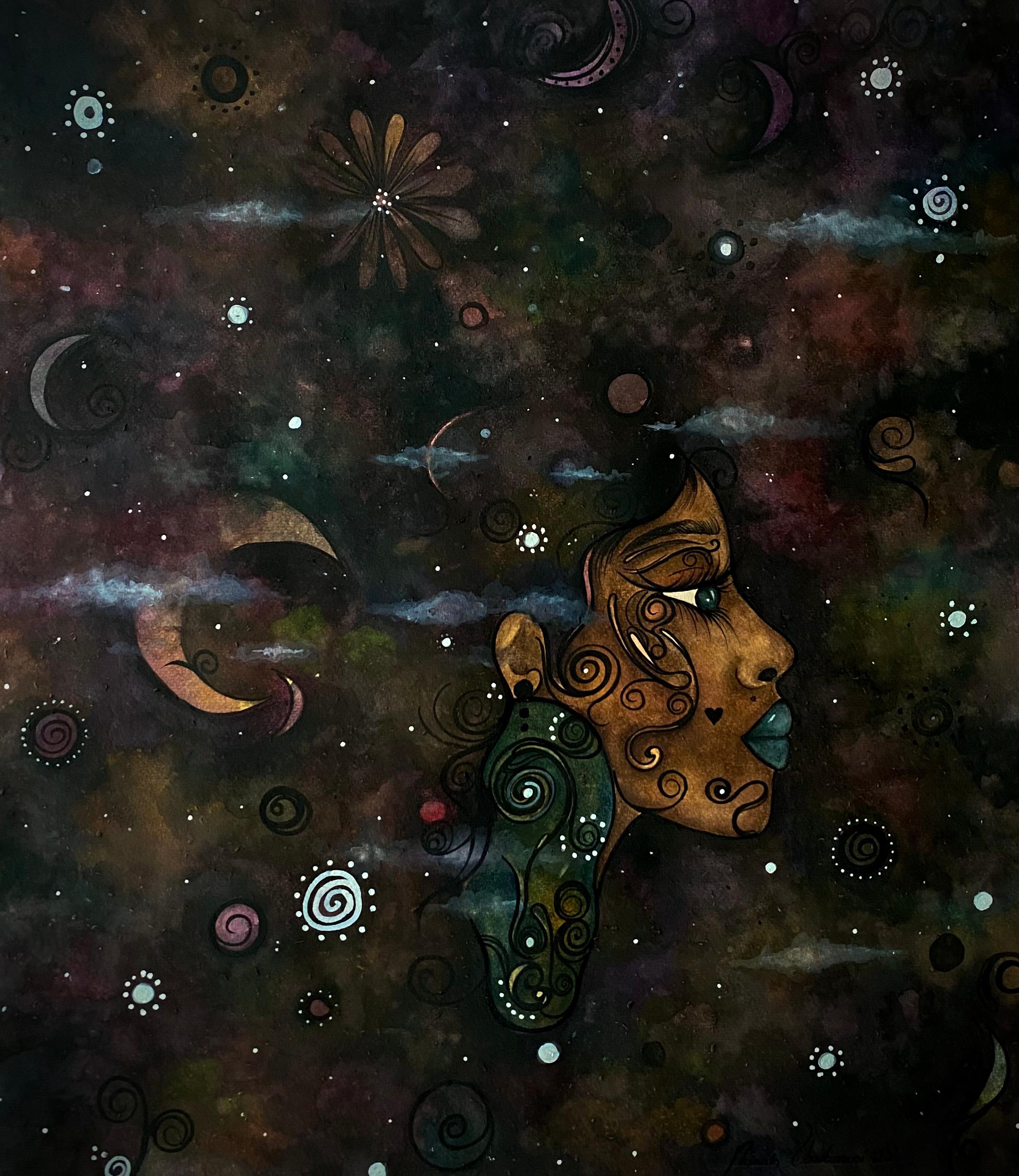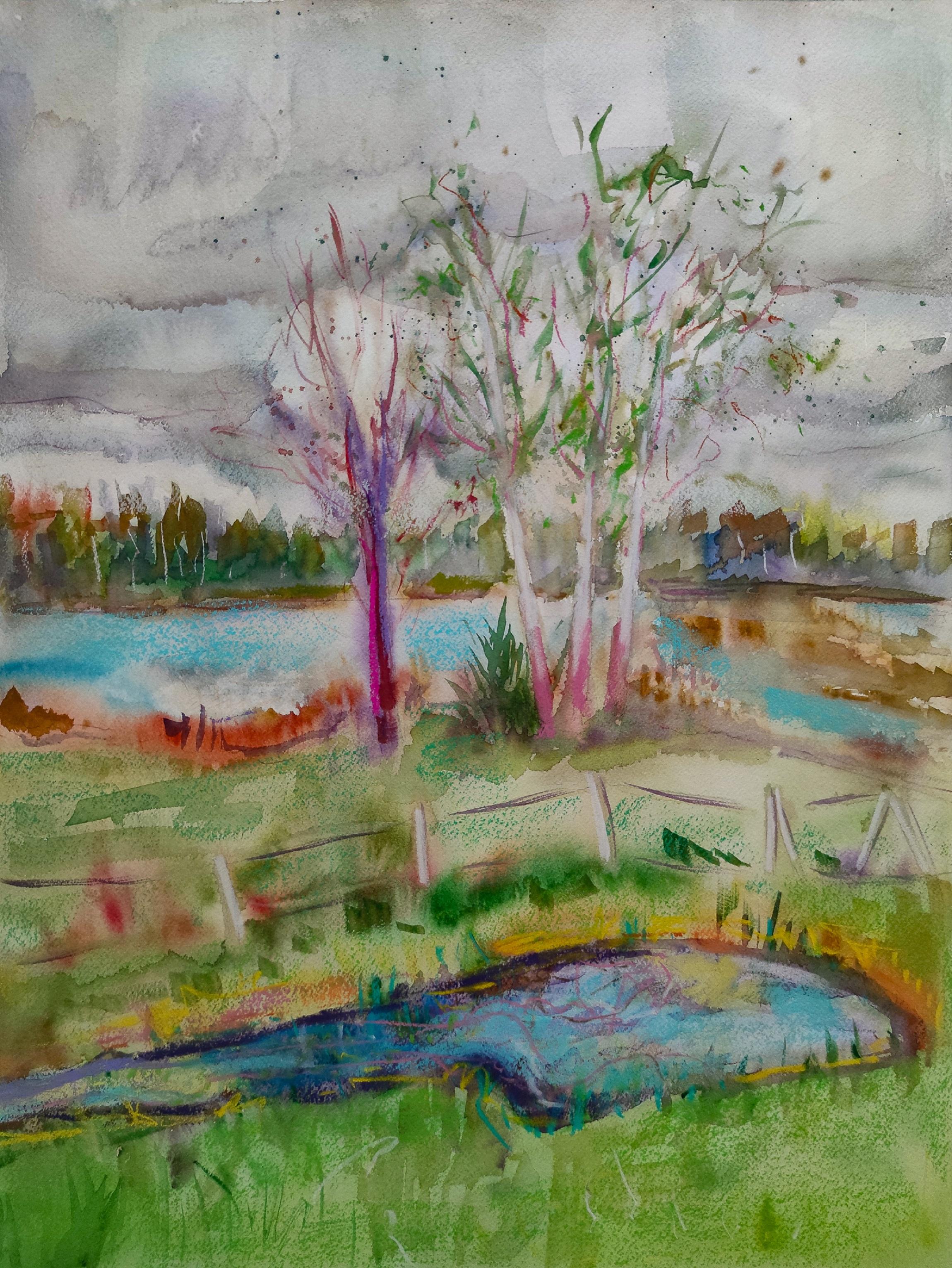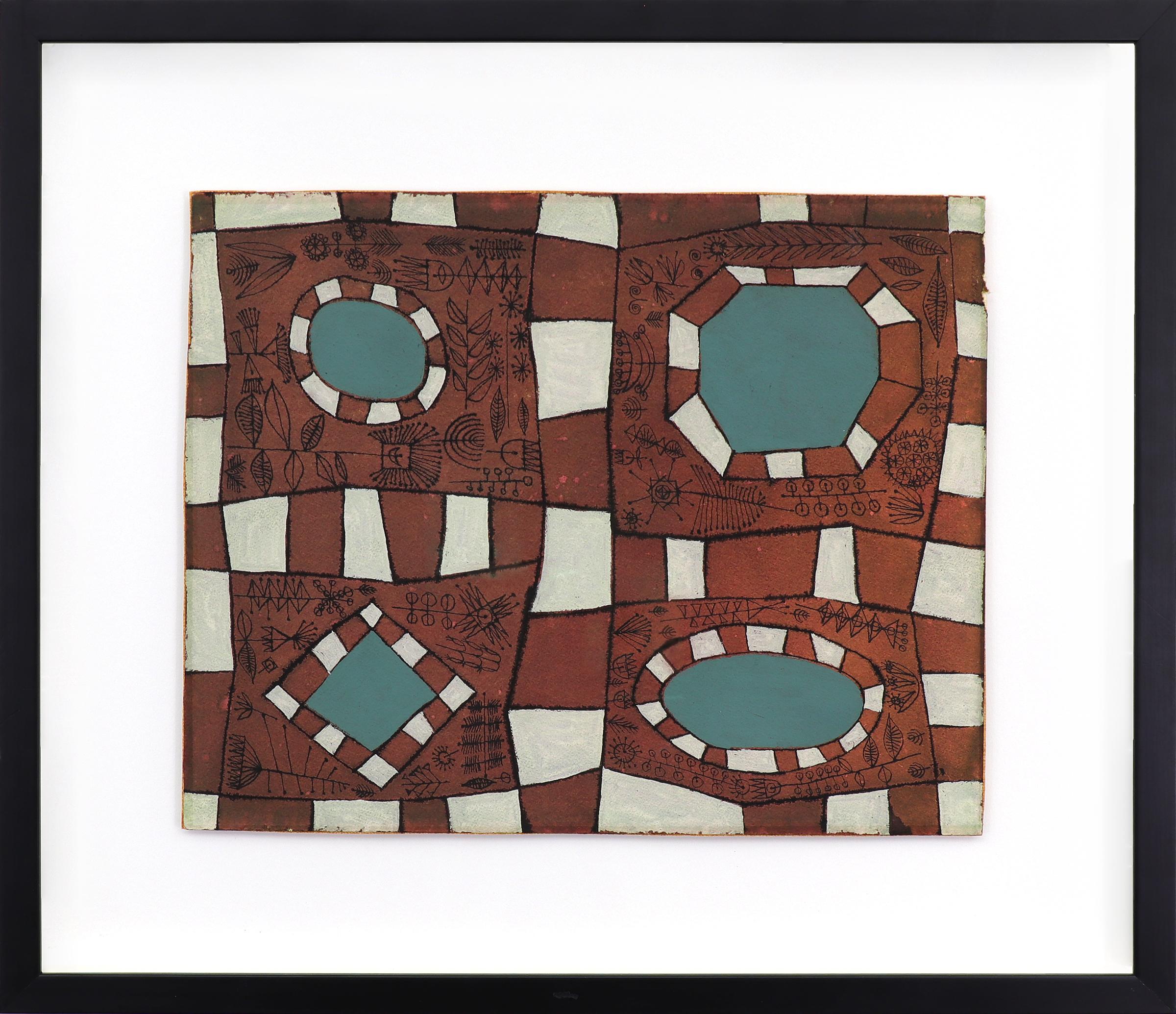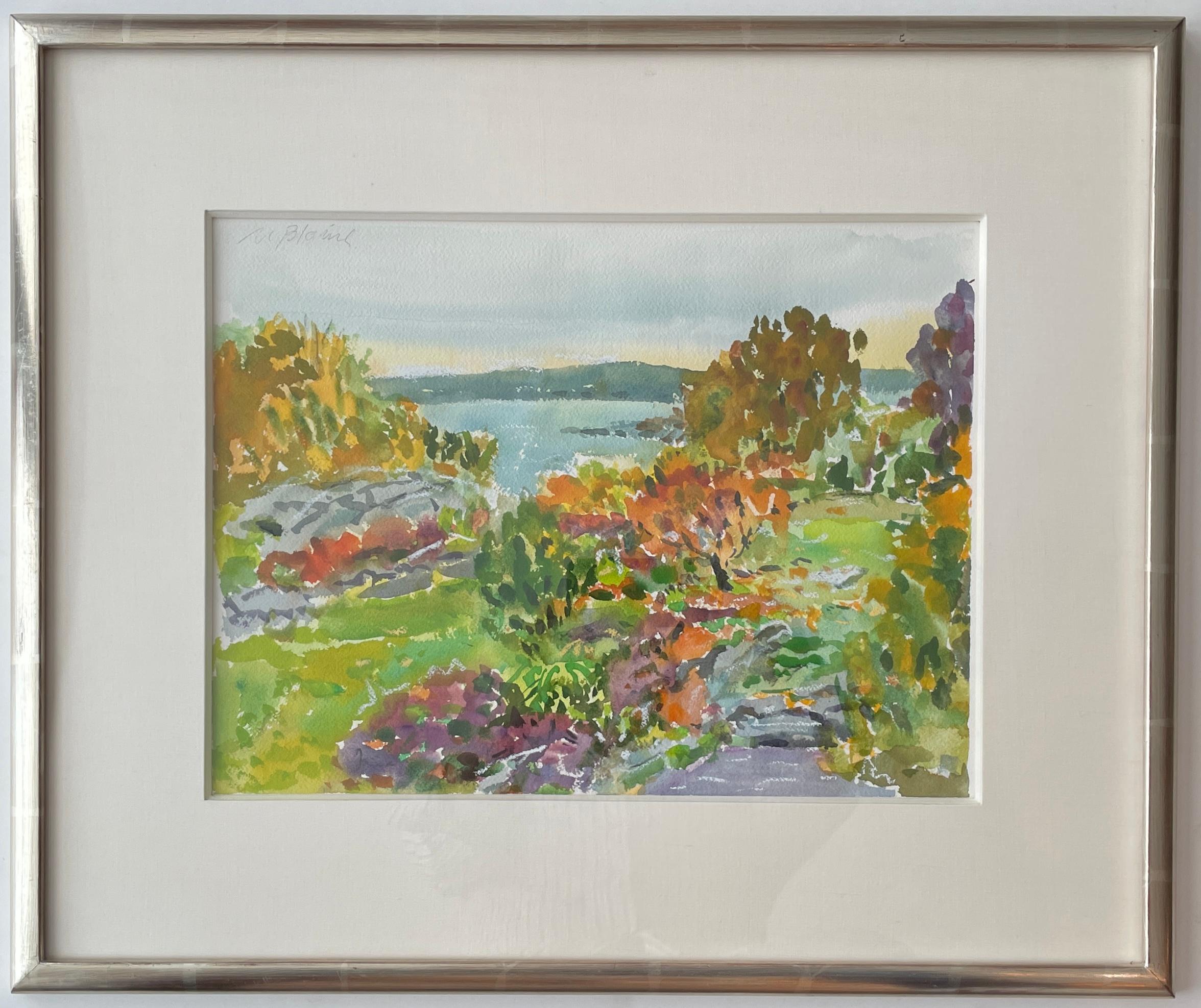Items Similar to Leon Underwood, British 20th Century summer landscape
Want more images or videos?
Request additional images or videos from the seller
1 of 11
Leon UnderwoodLeon Underwood, British 20th Century summer landscape1925
1925
About the Item
Leon Underwood (British, 1890 – 1975)
A River landscape in Italy
Signed, inscribed indistinctly and dated ’25.
Watercolour on paper
10.5/8 x 14.1/2 in. (27 x 37 cm.)
Underwood was known as the precursor of modern sculpture in Britain according to Neve Rothenstein in the work of 1974 but is also well known as a draftsman and engraver amongst other disciplines. He attended the Slade and founded the magazine ‘The Island’, in 1931. His work was influenced by African and Cycladic designs. In the First World War, he worked in camouflage design. In 1920 he won the British Prix de Rome but decided not to go to Italy. As well as being an artist he taught. Among his students was Henry Moore who would later declare his indebtedness to Underwood’s teaching. He made many commissions and murals and his work is held in many public collections including The Courtauld, The Tate Gallery, The National Portrait Gallery, The Victoria and Albert Museum and the Ashmolean. Pallant House devoted a recent exhibition to him in 2015 and the Henry Moore Foundation selected various works to put Moore’s work into context. There are very clear connections between this work and those of Henry Moore. The sculptural forms are abstracted with a foreboding grey and brown palette providing a moody composition.
- Creator:Leon Underwood (1890 - 1975)
- Creation Year:1925
- Dimensions:Height: 10.63 in (27.01 cm)Width: 14.5 in (36.83 cm)Depth: 1 in (2.54 cm)
- Medium:
- Movement & Style:
- Period:
- Condition:Paper may benefit bleaching, colours have possibly slight fading but overall in good condition. Recnetly remounted and framed in limed wood.
- Gallery Location:Petworth, GB
- Reference Number:1stDibs: LU54038228812
About the Seller
4.9
Platinum Seller
These expertly vetted sellers are 1stDibs' most experienced sellers and are rated highest by our customers.
Established in 2010
1stDibs seller since 2017
231 sales on 1stDibs
Typical response time: 3 hours
- ShippingRetrieving quote...Ships From: Petworth, United Kingdom
- Return PolicyA return for this item may be initiated within 10 days of delivery.
More From This SellerView All
- Modern British, St. Ives group William Black watercolour of three boatsLocated in Petworth, West SussexWilliam Black (British, fl.66-69) Three boats Watercolour and ink pen Inscribed with title, signed and dated `Three Boats William Black 68’ (lower edge) 8 x 5.3/4 in. (20.3 x 14.7 cm.) William Black is a little known and underrated member of the St Ives artist group who, having worked as an architect after the Second World War, went on to work as an artist following the inheritance of money in the early 1950s. He was a self taught artist, producing numerous deconstructivist sculptures in the 1960s. He moved to St Ives in Cornwall where he knew artists such as Ben Nicholson, Barbara Hepworth and Naum Gabo. There is a clear architectural element to the sculptures that he made . They illustrate an assemblage of fragmented shapes and forms of a deconstructivist nature. William Black’s artwork is very much rooted in the time and Cornish School...Category
20th Century Abstract Landscape Drawings and Watercolors
MaterialsInk, Watercolor
- Early 20th Century view of St. Ives harbour, Cornwall, UK by Fred BottomleyLocated in Petworth, West SussexFred Bottomley (British, 1883-1960) St Ives harbour Gouache and watercolour Signed `F. Bottomley.’ (lower right) 9.1/8 x 13.1/8 in. (23.2 x 33.4 cm.)Category
Early 20th Century Academic Landscape Drawings and Watercolors
MaterialsPaper, Gouache, Watercolor
- British 19th C watercolour of River Witham, Lincoln Cathedral beyond by GoodwinBy Albert GoodwinLocated in Petworth, West SussexAlbert Goodwin (British, 1845-1932) Cattle watering on the River Witham, Lincoln Cathedral beyond Watercolour Signed and dated ‘A.Goodwin, 1875’ (lower left) 5. 5/8 x 10. 3/4 in (14....Category
19th Century Academic Landscape Drawings and Watercolors
MaterialsPaper, Watercolor
- A 19th Century English watercolour of droving cattle before a woodland manorLocated in Petworth, West SussexEnglish School, 19th Century Droving cattle before a woodland manor Watercolour on paper with body colour 9.1/4 x 13.3/8 in. (23.5 x 34cm.) This is a very well executed watercolour landscape using body colour to create depth and contrast, in certain cases building up impasto depicting an idyllic rural scene of old England.Category
19th Century Academic Landscape Drawings and Watercolors
MaterialsWatercolor, Paper
- Jean Dufy, 1925 watercolour painting of the port of Le Havre, FranceBy Jean DufyLocated in Petworth, West SussexJean Dufy (French, 1888 – 1964) Vue de port du Havre, circa 1925 Watercolour on paper Signed ‘Jean Dufy’ (lower right) and inscribed on the reverse 19.1/4 x 23.1/4 in. (48.5 x 59 cm....Category
20th Century Expressionist Landscape Drawings and Watercolors
MaterialsPaper, Watercolor
- San Marco, Venice, circa 1986 watercolour by British artist John DoyleBy John DoyleLocated in Petworth, West SussexJohn Doyle MBE, PPRWS (British, b. 1928) San Marco, Venice, circa 1986 Acrylic and watercolour on paper Monogrammed (lower right) 6.1/4 x 9.7/8 in. (15.8 x 25 cm.) Provenance: The C...Category
20th Century Impressionist Landscape Drawings and Watercolors
MaterialsPaper, Watercolor, Acrylic
You May Also Like
- Autumn Garden Porch Abstracted Landscape with PumpkinsBy Les AndersonLocated in Soquel, CAColorful abstracted landscape of a garden porch in autumn with pumpkins by Les (Leslie Luverne) Anderson (American, 1928-2009). Signed "Les Anderson" lower right. Unframed. Image siz...Category
1980s Abstract Impressionist Landscape Drawings and Watercolors
MaterialsPaper, Watercolor
- EMI (Spirit): Mother EarthLocated in Ibadan, OyoEMI (Spirit): Mother Earth was created using Watercolour on 300gsm paper MOTHER-EARTH is considered a living being and the provider of all that is on Earth. Shipping Procedure Ship...Category
21st Century and Contemporary Abstract Expressionist Figurative Drawings...
MaterialsPaper, Watercolor
- Dyptic around the Episy marshesLocated in THOMERY, FRThis series of paintings is inspired by the relationship between the artist and the Fontainebleau forest region. Here we're talking about the Episy marsh, a sensitive, protected natu...Category
21st Century and Contemporary Abstract Impressionist Landscape Paintings
MaterialsPastel, Watercolor, Handmade Paper
- REVERIE AT THE MARSH OF EPISYLocated in THOMERY, FRThis series of paintings is inspired by the relationship between the artist and the Fontainebleau forest region. Here we're talking about the Episy marsh, a sensitive, protected natu...Category
21st Century and Contemporary Abstract Impressionist Landscape Drawings ...
MaterialsHandmade Paper, Watercolor, Pastel
- A Small City Park, Abstract Painting Acrylic Watercolor Painting, Green BrownBy Edward MarecakLocated in Denver, CO"A Small City Park", acrylic and watercolor on paper by Denver artist Edward Marecak (1919-1993) of an abstract park broken into four quadrants, separated by brown and white striped borders with different shaped ponds. Inspired by City Park in Denver, Colorado where the artist frequented. Presented framed with all archival materials, outer dimensions measure 21 ¾ x 18 ¾ inches. Image size measures 12 x 15 inches. Painting is clean and in good condition - please contact us for a detailed condition report. Provenance: Estate of Edward Marecak Expedited and international shipping is available - please contact us for a quote. About the Artist: Born to immigrant parents from the Carpathian region in Slovakia, Marecak grew up with his family in the farming community of Bennett’s Corners, now part of the town of Brunswick, near Cleveland, Ohio. When he turned twelve, his family moved to a multi-ethnic neighborhood of Poles, Czechs, Slovaks and Slovenians in Cleveland. His childhood household cherished the customs and Slavic folk tales from the Old Country that later strongly influenced his work as a professional artist. During junior high he painted scenery for puppet shows of "Peter and the Wolf," awakening his interest in art. In his senior year in high school he did Cézanne-inspired watercolors of Ohio barns at seventy-five cents apiece for the National Youth Administration. They earned him a full scholarship to the Cleveland Institute of Art (1938-1942) where he studied with Henry George Keller whose work was included in the 1913 New York Armory Show. In 1940 Marecak also taught at the Museum School of the Cleveland Institute. Before being drafted into the military in 1942, he briefly attended the Cranbrook Academy of Art near Detroit, one of the nation’s leading graduate schools of art, architecture, and design. A center of innovative work in architecture, art and design with an educational approach built on a mentorship model, it has been home to some of the world’s most renowned designers and artists, including Eero Saarinen, Charles Eames, Daniel Libeskind and Harry Bertoia. Marecak’s studies at Cranbrook with painter Zoltan Sepeshy and sculptor Carl Milles were interrupted by U.S. army service in the Aleutian Islands during World War II. Following his military discharge, Marecak studied on the G.I. Bill at the Colorado Springs Fine Arts Center from 1946 to 1950, having previously met its director, Boardman Robinson, conducting a seminar in mural painting at the Cleveland Institute of Art. Although he did not work with Robinson at the Fine Arts Center, who had become quite ill - retiring in 1947 - he studied Robinson’s specialty of mural painting before leaving to briefly attend the Cranbrook Academy in 1947. That same year he returned to the Fine Arts Center, studying painting with Jean Charlot and Mary Chenoweth, and lithography with Lawrence Barrett with whom he produced some 132 images during 1948-49. At the Fine Arts Center he met his future wife, Donna Fortin, whom he married in 1947. Also a Midwesterner, she had taken night art courses at Hull House in Chicago, later studying at the Art Institute of Chicago with the encouragement of artist Edgar Britton. After World War II she studied with him from 1946 to 1949 at the Fine Arts Center. (He had moved to Colorado Springs to treat his tuberculosis.) Ed Marecak also became good friends with Britton, later collaborating with him on the design of large stained glass windows for a local church. In 1950-51 Marecak returned to the Cleveland Institute of Art to complete his Bachelor of Fine Arts degree. A year later he was invited to conduct a summer class at the University of Colorado in Boulder, confirming his interest in the teaching profession. In 1955 he received his teaching certificate from the University of Denver. Vance Kirkland, the head of its art department, helped him get a teaching job with the Denver Public Schools so that he and his family could remain in the Mile High City. For the next twenty-five years he taught art at Skinner, Grove, East, George Washington and Morey Junior High Schools. Prior to coming to Colorado, Marecak did watercolors resembling those of Winslow Homer, John Singer Sargent and Charles Burchfield. However, once in Colorado Springs he decided to destroy much of his earlier ouevre, embarking on a totally new direction unlike anything he had previously done. Initially, in the 1940s he was influenced by surrealist imagery and Paul Klee, and in the West by Indian petroglyphs and Kachinas. His first one-person show at the Garrett Gallery in Colorado Springs in 1949 featured paintings and lithographs rendered in the style of Magic Realism and referential abstraction. The pieces, including an oil Witch with Pink Dish, foreshadowed the output of his entire Colorado-based career, distinguished by a dramatic use of color, intricacy of execution and attention to detail contributing to their visual impact. He once observed, "Each time I start a new painting I always fool myself by saying this time keep it simple and not get entangled with such complex patterns, color and design; but I always find myself getting more involved with richness, color and subject matter." An idiosyncratic artist proficient in oil, acrylic, watercolor, gouache and casein, he did not draw upon Colorado subject matter for his work, unlike many of his fellow painters in the state. Instead he used Midwest landscape imagery, bringing to life in it witches and spirits adapted from the Slovakian folk tales he heard growing up in Ohio. A number of his paintings depict winter witches derived from the Slovak custom in the Tatra Mountains of burning an effigy of the winter witch in the early spring to banish the memory of a hard winter. The folk tale element imparts a dream-like quality to many of his paintings. A devote of Greek mythology, he placed the figures of Circe, Persephone, Sybil, Hera and others in modern settings. The goddess in Persephone Brings a Pumpkin to her Mother, attired as a Midwestern farmer’s daughter, heralds the advent of fall with the pumpkin before departing to spend the winter season in the underworld. Train to Olympus, the meeting place of the gods in ancient Greece, juxtaposes ancient mythology with modernity creating a combination of whimsy and thought-provoking consideration for the viewer. Voyage to Troy #1 alludes to the ancient city that was the site of the Trojan Wars, but has a contemporary, autobiographical component referencing the harbor of the Aleutian Islands recaptured from the Japanese during World War II. In the 1980s Marecak used the goddess Hera in his painting, Hera Contemplates Aspects of the Art Nouveau, to comment on art movements in the latter half of the twentieth century Marecak’s love of classical music and opera, which he shared with his wife and to which he often listened while painting in his Denver basement studio, is reflected in Homage of Offenbach, an abstract work translating the composer’s musical colors into colorful palette. Pace, Pace, Mio Dio, the title of his earliest surrealist painting, is a soprano aria from Verdi’s opera, La Forza del Destino (The Force of Destiny or Fate, a favorite Marecak subject). His Queen of the Night relates to a character from Mozart’s opera, The Magic Flute. In addition to paintings and works on paper, he produced hooked rugs, textiles and ceramics. He likewise produced designs for ceramics, tableware and furniture created by his wife Donna, an accomplished Colorado ceramist. Both of them generally eschewed exhibitions and galleries, preferring to quietly do their work while remaining outside of the mainstream. He initially exhibited at the Colorado Springs Fine Arts Center in 1948 receiving a purchase award. The following year he had his first one-person show of paintings and lithographs at the Garrett Gallery in Colorado Springs. In the 1950s and early 1960s he participated in group exhibitions at the Print Club (Philadelphia); Amarillo Public Library (Texas); annual Blossom Festival Show (Canon City, Colorado); Adele Simpson’s "Art of Living" in New York; Denver Art Museum; and the Fox Rubenstein-Serkey Gallery (Denver); but he did not have another one-person show until 1966 at the Denver home of his friends, John and Gerda Scott. They arranged for his first one-person show outside of Colorado held two years later at the Martin Lowitz Gallery in Beverly Hills and Palm Springs, California. That same year his work was featured at the Zantman Galleries in Carmel, California. Thereafter he became an infrequent exhibitor after the 1970s so that his work was rarely seen outside his basement studio. In 1980 he, his wife and Mark Zamantakis exhibited at Denver’s Jewish Community Center, and four years later he had a one-person show at the Studio Gallery in Denver. In 1992 he was included in a group show at the Rule Modern and Contemporary Gallery in Denver, and a year later received a large, posthumous retrospective at the Emmanuel...Category
Mid-20th Century Abstract Abstract Paintings
MaterialsPaper, Acrylic, Watercolor
- Touch of Fall watercolor and pastel painting by Nell BlaineBy Nell BlaineLocated in Hudson, NYSigned "Nell Blaine" upper left in pencil. Signed, titled, dated verso on sheet. Signed, titled, dated verso on backing panel. The artist. Exhibited at Fischbach Gallery, NYC, in 1994 (Gallery label verso, and wall label affixed verso). Purchased by private collectors c.1994. By descent. Tibor de Nagy Gallery, NYC (the artist's estate representative), exhibited 2020 (label verso). Exhibited at Fischbach Gallery, NYC, in 1994 (Gallery label verso, and wall label affixed verso). Tibor de Nagy Gallery, NYC (the artist's estate representative), exhibited 2020 (label verso). From her November 15, 1996 NYT obituary: Nell Blaine, a widely respected New York landscape painter and watercolorist, died yesterday at Mount Sinai Hospital. She was 74 and had homes in Manhattan and Gloucester, Mass. Ms. Blaine, who had been hospitalized since July, had been confined to a wheelchair since 1959, when she contracted polio. Ms. Blaine was born in Richmond, Va., in 1922, and first studied at the Richmond School of Art, now part of Virginia Commonwealth University. She moved to New York in 1942 to study painting with Hans Hofmann and later studied etching and engraving at Atelier 17 with Stanley William Hayter. During her first years in New York, her work, which had previously been tightly realist, turned abstract, inspired by Mondrian, Leger and Jean Helion. At one time she was the youngest member of the American Abstract Artists. She was also a founding member of the Jane Street Gallery, one of Manhattan's earliest artists' cooperatives, and had her first solo show there in 1945. Just as Ms. Blaine was becoming known as a promising abstract painter, and gaining the admiration of such critics as Clement Greenberg, she started to shift back to representation. Inspired in part by a trip with Larry Rivers in 1950 to Paris, where she was especially impressed by the work of Vuillard and Bonnard, she immersed herself in the tradition of 19th-century European painting. From the mid-1950's, she cultivated an increasingly painterly and colorful style, usually working directly from nature, or still life, with particular emphasis on the forms and hues of flowers. Her work retained a sense of all-over structure and pulsating energy that she nonetheless credited to abstract art. ''It all goes back to Mondrian,'' she would say. In the 1950's, Ms. Blaine was prominent among a circle of New York artists and poets that included John Ashbery, Frank O'Hara, Kenneth Koch, Mr. Rivers, Jane Freilicher, Leland Bell, Louisa Matthiasdottir, Robert De Niro Sr. and Rudy Burckhardt. She had her first solo show of representational work at the Tibor de Nagy Gallery in 1953 and was represented by the Poindexter Gallery until it closed in 1978, and, in recent years, by the Fischbach Gallery. During the 1950's she supported herself as a commercial artist, designing brochures for art galleries. In 1955, she designed the original logo, column heads and layout for The Village Voice. In 1957, Ms. Blaine was featured in Life magazine as one of five leading young female artists in America. In 1959, after several months of traveling and painting in Greece, she contracted severe bulbar polio on the island of Mykonos. ''To Nell Blaine,'' an exhibition organized at Poindexter to raise money for her hospital bills, included the work of 79 artists, including Saul Steinberg, Robert Motherwell, Elaine and Willem de Kooning, Philip Guston, Mr. Rivers, Ms. Freilicher and Robert Rauschenberg. After eight months in a New York hospital, including five months in an iron lung...Category
1990s Abstract Impressionist Landscape Drawings and Watercolors
MaterialsPaper, Watercolor, Pastel
Recently Viewed
View AllMore Ways To Browse
Leon Leon
20th Century British Landscapes
Vintage Italian Summer
Vintage Summer House
Leon Leon Design
Africa British
Victoria Rivers
Cycladic Art
Vintage Neve
Underwood Vintage
Leon Underwood
Contemporary Oil Painting
Oil On Canvas Framed
Takefumi Hori On Sale
Vee Speers On Sale
Traditional Art
Painting By Wells
What Not





